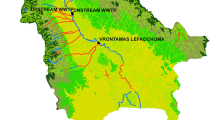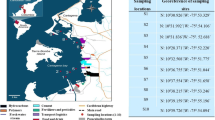Abstract
Thirteen sediment cores of 1.5–6 m depth were collected from the lower Passaic River in Newark, New Jersey and assayed for metals, total petroleum hydrocarbons, polycyclic aromatic hydrocarbons (PAHs), and Aroclor® and coplanar polychlorinated biphenyls (PCBs). Chronological profiles of chemical concentrations at specified depths and sediment accumulation rates in each core were determined by 137Cs and 210Pb radioisotope measurements. Temporal concentrations of these chemicals were compared to available benchmark sediment toxicity values to assess historic and current toxic hazards to aquatic organisms. Elevated concentrations of several metals, including copper, lead, mercury, nickel, and zinc, were found in surface and buried sediments at concentrations that greatly exceeded Long and Morgan (1991) Effects Range-Low (ER-L) and Effects Range-Median (ER-M) values. Aroclors® 1242, 1248, and 1254 and several PAHs were also found at concentrations exceeding Long and Morgan (1991) benchmark toxicity values. In general, the highest metal and PAH concentrations were found in sediment deposited prior to the 1960s. Elevated PCB concentrations were found in sediment deposited between 1950 and 1980. The results indicate that the lower Passaic River is heavily contaminated due to recent and historical municipal and industrial discharges from local and up-stream sources. The primary sources of PCBs, PAHs, and metals appear to be discharges of industrial effluents either directly into the waterway or through combined sewer overflows. Additional inputs are probably from urban runoff entering through combined sewer overflows and storm drains.
Similar content being viewed by others
References
API (American Petroleum Institute) (1978) Fate and effects of polynuclear aromatic hydrocarbons in the aquatic environment. Publication No. 4297. Washington, DC
Bertine KK, Mendeck MF (1978) Industrialization of New Haven, Conn., as recorded in reservoir sediments. Environ Sci Technol 12(2):201–206
Bopp RF, Simpson HJ, Olsen CR, Trier RM, Kostyk N (1982) Chlorinated hydrocarbons and radionuclide chronologies in sediments of the Hudson River and estuary, New York. Environ Sci Technol 16:666–676
Bopp RF, Gross ML, Tong H, Simpson HJ, Monson SJ, Deck BL, Moser FC (1991) A major incident of dioxin contamination: Sediments of New Jersey estuaries. Environ Sci Technol 25:951–956
Breteler RJ, Bowen VT, Schneider DL, Henderson R (1984) Sedimentological reconstruction of the recent pattern of mercury pollution in the Niagara River. Environ Sci Technol 18:404–409
Brydon DF (1974) The Passaic River: Past, present, and future. Rutgers University Press, New Brunswick, NJ
Cunningham JT (1966a) New Jersey, America's main road. Doubleday, NY
— (1966b) Newark. New Jersey Historical Society, Newark, NJ
Forstner U (1990) Inorganic sediment chemistry and elemental speciation. In: Baudo R, Giesey J, Muntau H (eds) Sediments: Chemistry and toxicity of in -place pollutants. Lewis Publishers, Chelsea, MI, pp 61–105
Gilbert T, Clay A, Karp CA (1976) Distributions of polluted materials in Massachusetts Bay. New England Aquarium, Boston, p 173
Goldberg ED, Gamble E, Griffin JJ, Koide M (1977) Pollution history of Narragansett Bay as recorded in its sediments. Estuar Coastal Mar Sed 5:549–561
Goldberg ED, Hodge V, Koide M, Griffin J, Gamble E (1978) A pollution history of Chesapeake Bay. Geochim Cosmochim Acta 42:1413–1425
Goldberg ED, Griffin JJ, Hodge H, Koide M (1979) Pollution history of the Savannah River estuary. Environ Sci Technol 13:588–594
Gunster DG, Bonnevie NL, Gillis CA, Wenning RJ (1993) Assessment of chemical loadings to Newark Bay, New Jersey for petroleum and hazardous chemical accidents from 1986–1991. Ecotoxicol Environ Safety 25:202–213
Hass CN, Scheff (1990) Estimation of averages in truncated samples. Environ Sci Technol 24:(6):912–919
Helz GR, Huggett RJ (1987) Contaminants in Chesapeake Bay. In: Majumdar, Hall SK, Austin LW (eds) Contaminant problems and management of living Chesapeake Bay resources. Penn Acad Sci Pub, Philadelphia, pp 270–297
Hugget RJ, Bender ME (1980) Kepone in the James River. Environ Sci Technol 14(8):918–923
Hurtt AC, Quinn JG (1979) Distribution of hydrocarbons in Narragansett Bay sediment cores. Environ Sci Technol 13(7):829–836
ISC (Interstate Sanitation Commission) (1988) Combined sewer outfalls in the interstate sanitation district. NY
IT Corp (International Technology Corporation) (1986) Passaic River sediment study, Final Report. Pittsburgh, PA. Prepared for the New Jersey Department of Environmental Protection, Trenton, NJ
Killam Associates (1976) Report upon overflow analysis to Passaic Valley Sewerage Commissioners on Passaic River overflows. Trenton, NJ
Lavelle JW, Massoth GJ, Crecelius EA (1986) Accumulation rates of recent sediments in Puget Sound, Washington. Mar Geol 72:59–70
Long ER (1992) Ranges in chemical concentrations in sediments associated with adverse biological effects. Mar Pollut Bull 24(1):38–45
Long ER, Morgan LG (1991) The potential for biological effects of sediment-sorbed contaminants tested in the national status and trends program. Office of Coastal and Estuarine Assessment, Seattle, WA
Long ER, Wolfe DA, Stern EA, Thursby GB (1993) Sediment toxicity in the Hudson-Raritan Estuary. In: Society of Environmental Toxicology and Chemistry (SETAC), 14th annual meeting: Ecological risk assessment: Lessons learned? Abstract #341. Nov. 14–18, Houston, TX
McLean RI, Summers JK, Olsen CR, Domotor SL, Larsen IL, Wilson H (1991) Sediment accumulation rates in Conowingo Reservoir as determined by man-made and natural radionuclides. Estuaries 14(2):148–156
Meyers WS (1945) The story of New Jersey. Lewis Historical Publ, NY, Vols 1–4
Meyerson AL, Luther GW, Krajewski J, Hires RI (1981) Heavy metal distribution in Newark Bay sediments. Mar Pollut Bull 12(7):244–250.
Monsanto (1971) The Aroclors®. Physical properties and suggested applications. Applications data bulletin NO-P-115. Organic Chemicals Division, Monsanto Chemical Co, St. Louis, MO
Mueller JA, Gerrish TA, Casey MC (1982) Contaminant inputs to the Hudson-Raritan estuary. NOAA Technical Memorandum OMPA-21, Boulder, CO
Mueller JG, Chapman PJ, Pritchard PH (1989) Creosote-contaminated sites. Environ Sci Technol 23(10):1197–1201
NJDEPE (New Jersey Department of Environmental Protection and Energy) (1989) Hazardous Waste Program Site Status Report. Hazardous Waste Management Program, Trenton, NJ
NRC (National Research Council) (1989) Contaminated marine sediments—Assessment and remediation. National Academy Press, Washington, DC
O'Connor JM, RJ Huggett (1988) Aquatic pollution problems, North Atlantic coast, including Chesapeake Bay. Aquatic Toxicol 11:163–190
Orson RA, Simpson RL, Good RE (1990) Rates of sediment accumulation in a tidal freshwater marsh. J Sed Petrol 19:859–869
Pempkowiak J (1991) Enrichment factors of heavy metals in the southern Baltic surface sediments dated with 210Pb and 137Cs. Environ Int 17:421–428
Pierce RH, Brown RC, Van Vleet ES, Joyce RM (1986) Hydrocarbon contamination from coastal development. In: Sohn MC (ed) Organic marine geochemistry. ACS Symposium Series 305. American Chemical Society, Washington, DC
PVSC (Passaic Valley Sewerage Commissioners) (1992) Pretreatment program annual report for 1992, Newark, NJ
Rice CP, White DS (1987) PCB availability assessment of river dredging using caged clams and fish. Environ Toxicol Chem 6:259–274
Rod SR, Ayres RU, Small M (1989) Reconstruction of historical loadings of heavy metals and chlorinated hydrocarbon pesticides in the Hudson-Raritan Basin, 1880–1980. Carnegie Mellon University, Pittsburgh, PA
Safe S (1990) Polychlorinated biphenyls (PCBs), dibenzo-p-dioxins (PCDDs), and dibenzofurans (PCDFs), and related compounds: Environmental and mechanistic considerations which support the development of toxic equivalency factors. Crit Rev Toxicol 21:51–88
Segar DA, Davis PG (1984) Contamination of populated estuaries and adjacent coastal ocean—A global review. NOAA Technical Memorandum NOS OMA 11, Rockville, MD
Stratton CL, Sosebee JB (1976) PCB and PCT contamination of the environment near sites of manufacture and use. Bull Environ Contam Toxicol 10:1229–1233
Sugai SF (1990) Transport and sediment accumulation of 210Pb and 137Cs in two southeast Alaskan fjords. Estuaries 13(4):380–392
Suszkowski DJ (1978) Sedimentology of Newark Bay, New Jersey: An urban estuarine bay. PhD Dissertation. University of Delaware, Newark, DE
Tanabe S, Kannan N, Wakimoto T, Tatsukawa R, Okamota T, Masuda Y (1989) Isomer-specific determination and toxic evaluation of potentially hazardous coplanar PCBs, dibenzofurans, and dioxins in the tissues of “Yusho” PCB poisoning victims and in the causal oil. Toxicol Environ Chem 24:215–225
Tsai CJ, Welsh J, Chang K, Shaeffer J, Cronin LE (1979) Bioassay of Baltimore Harbor sediments. Estuaries 2(3):141–153
USEPA (US Environmental Protection Agency) (1983) Environmental transport and transformation of polychlorinated biphenyls. EPA 560/5-83-025. Washington, DC
-- (1986) Development of advisory levels for polychlorinated biphenyls (PCBs) cleanup. EPA 600/6-86/002. Washington, DC
— (1990) Method 1613: Tetra- through octa-chlorinated dioxins and furans by isotope dilution—HRGC/HRMS. Revision A. Washington, DC
-- (1991a) Contract laboratory program statement of work for inorganic analysis, multi-media, multi-concentration. ILMO2.0. Washington, DC
-- (1991b) Contract laboratory program statement of work for organic analysis, multi-media, multi-concentration. OLM 0.6. Washington, DC
Van Dolah RF, Knott DM, Wenner EL, Mathews TD, Katuna MP (1984) Benthic and sedimentology studies of the Georgetown ocean dredged material disposal site. South Carolina Marine Resources Center Technical Report No. 59. Marine Resources Institute South Carolina Wildlife and Marine Resources Department, Charleston, SC, p 97
Weaver G (1984) PCB contamination in and around New Bedford, Mass. Environ Sci Technol 18:22A-27A
Author information
Authors and Affiliations
Rights and permissions
About this article
Cite this article
Wenning, R.J., Bonnevie, N.L. & Huntley, S.L. Accumulation of metals, polychlorinated biphenyls, and polycyclic aromatic hydrocarbons in sediments from the lower Passaic River, New Jersey. Arch. Environ. Contam. Toxicol. 27, 64–81 (1994). https://doi.org/10.1007/BF00203890
Received:
Revised:
Issue Date:
DOI: https://doi.org/10.1007/BF00203890




